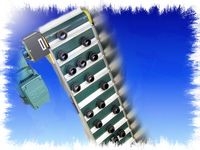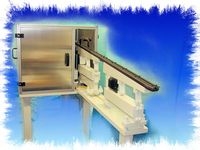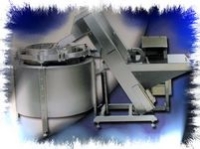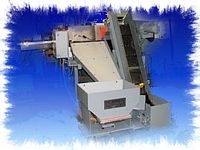VIBROMATIC - DESIGNER AND BUILDER OF PART HANDLING SYSTEMS COMPARES VARIOUS PARTS FEEDING SOLUTIONS
Learn what to look for when selecting your parts handling system. There are numerous types of systems to choose from. How do you go about this process of selecting vendors and parts feeding equipment.
|
Related Links Full line of part handling systems. Get quotation from a Vibromatic estimating engineer. |
Vibromatic Part Handling Systems Comparisions (Press Release) - In an interview with Mr. Neal Graham, President of Vibromatic Vibratory Feeder Bowls, Inc., we asked him the question; is there any type of part handling system that is superior to another? His answer was “No, before choosing a particular type part handling system and vendor to design and build it, there are many issues that must be addressed”. On the surface, this may seem like a simple questions but once you understand the number of variables that must be taken into consideration, it becomes rather complex.
Here are some of the issues, as explained by Mr. Graham, which must be considered:
 First of all let’s take a look at a few types of part handling systems that Vibromatic designs and builds:
First of all let’s take a look at a few types of part handling systems that Vibromatic designs and builds:
- Centrifugal Feeders
- Vibratory Feeders
- Belt /Vibratory Straight Line (Linear) Feeders
- Straight Line Storage Feeders
- Gravity Storage Feeders

- Rotary Hopper Feeders
- Stepper Feeders
Why isn't one kind of system superior to another? Mr. Graham States that “Vibromatic evaluates each individual application and then determines which type will provide the best solution for solving our customer’s production problems”.
Let’s take a look at some examples that Mr. Graham has present that will help explain why “application” determines which system to use.
 “Let’s talk about one of the easier family of parts to deal with; headed parts. Say you require a part handling system for a 1" long cap screw that is to be fed hanging by the head at a rate of 30 per minute. This is a relatively easy problem to solve considering the rate and orientation required. Any one of the systems described above would handle this application reliably under a given set of requirements”.
“Let’s talk about one of the easier family of parts to deal with; headed parts. Say you require a part handling system for a 1" long cap screw that is to be fed hanging by the head at a rate of 30 per minute. This is a relatively easy problem to solve considering the rate and orientation required. Any one of the systems described above would handle this application reliably under a given set of requirements”.
However there are any number of factors such as rate, part orientation, production conditions, number of tracks or minimum recirculation requirements that will effect the decision making process. It will be tile responsibility of your supplier to determine what type part handling system fits your application best.
There are many conditions that influence this decision making process. If this screw must be presented end to end with the head leading, the requirements of the system will be more complex even though it is still a relatively easy problem to solve. If the orientation requirement is head trailing this will create a different set of problems. Or maybe the requirement is diameter to diameter standing on the head.
Another factor is rate. Say instead of 30 parts per minute the requirement changes to 200 per minute. Again this changes the method in which the problem is solved. Or instead of a single line of parts maybe multiple lines of parts are required.
As an example, Honda had a problem fitting four feed and escape mechanisms for bolts into a very confined area. The solution, in this case was to position a four track vibratory bowl above the assembly machine on a mezzanine, and escape the bolts with the head trailing, allowing them to drop through flex tubes to four work stations below. With enough space, other type feed systems would have been acceptable for handling this bolt. However, given the space parameters coupled with the multiple track requirement, the vibratory bowl was the logical solution to this production problem.)
Another factor that may affect the solution is part condition. If the parts are coated with oil or some other substance, the method in which the problem is solved will be affected.
The point here is when you read an article or talk to a manufacture that makes a general claim that one type feed system is superior over another without addressing the factor of application it's time to question the validity of this line of reasoning.
Some manufactures believe that certain types of systems are more jam free than others. Again, for this to be a valid claim it must be accompanied with some qualifying statements. Tooling principles remain consistent regardless of system type. Good design techniques along with proper choice of system for the application will prevent jamming problems along with providing overall efficiency.
A manufacturer may say, "Our systems are more economical because we offer fewer options". Realistically there are certain elements that are required for any feed system regardless of whether they are included in the base price or offered separately as options. Typically this would include bulk storage, some type of feeder such as the examples mentioned above, some method of tracking the parts from the feeder to the station, and sometimes a mechanism.
Air assist is an important issue to address. It must be avoided whenever possible to achieve the best efficiency in production at the lowest operating cost. The abuse of air assist may occur with any type feed system. However, through good sound design practices and proper choice of system, air assist can be held to an absolute minimum if not eliminated entirely.
Another factor is heat treated tooling. This is a matter of builder specifications. The use of tool steel can be applied to any part handling system. It depends entirely upon the company's build specifications.
Noise level is another factor to consider. Some feed systems are noisier than others which bring up a good point. If your supplier has the capability of tooling a variety of feed systems you will see better end results. Maybe you have several parts to automate on one project. There may be parts that are made of various materials or different sizes, or possibly delicate parts that require special handling. If the vendor has the flexibility to choose from a variety of systems, he will have the capability to provide one that will solve the noise problem, the delicate handling problem and handling multiple or larger families of parts at a more cost effective level, all from a single source.
Other advantages this single source vendor can offer is the capability to providing multiple line tooling, adjustable tooling for handling multiple parts within a common feed system, quick changeover systems and easy access tooling.
This same theory applies to retooling a system for a part change. If there is a minor part change any system may be retooled. If there is a major part change to contend with, more than likely the system, regardless of the type will have to be replaced with a new concept.
Mr. Graham concludes that “The ultimate solution to your part handling, problem will be found only after considering all alternatives. This goal will be met by choosing a vendor that manufactures a complete line of part handling equipment. All of the above mentioned systems have been around for a long time. Some may be more versatile and popular than others but they all have there advantages depending upon the supplication. It's up to the single source vendor to make the choice that will provide the most efficiency in production”.